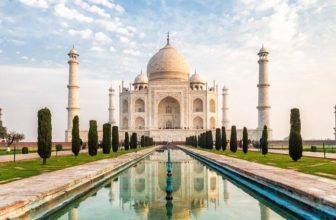Maha Bodhi Temple, Bodhgaya Bihar
A unique property of cultural and archaeological importance and is also recognized by UNESCO as World Heritage site in the world that spread over an area of 4.86 hectares. It is a great example of the earliest buildings which have sustained till now. The first temple was built by Emperor Asoka in the 3rd century BC (260 BC) around the Bodhi Tree, i.e. Ficus religiosa (to the west of the temple). Revered and sanctified as the place where Siddhartha Gautama Buddha was enlightened in 531 BC at age 35, and then propagated his divine knowledge of Buddhism to the world, it has been the ultimate temple for reverential worship, over the last several centuries, by Buddhists of all denominations, from all over the world who visits on pilgrimage.
The main temple is 50 m in height, built in Indian architectural style, and it is the oldest temple in the Indian sub-continent built during the “Golden Age” of Indian culture credited to the Gupta period. Sculpted balustrades of the Asoka times (3rd century BC) are preserved in the Archaeological Museum located within the temple complex. It is considered to be a fine example of Indian brickwork, and was highly influential in the development of later architectural traditions.
In approximately 250 BCE, about 200 years after the Buddha attained Enlightenment, Buddhist Emperor Asoka visited Bodh Gaya with the intention of establishing a monastery and shrine. As part of the temple, he built the diamond throne (called the Vajrasana), attempting to mark the exact spot of the Buddha’s enlightenment. Prior to that, there seems to have been a pyramidal structure perhaps built in about the second century (Kusana period). Knowledge of it comes only from a small, circa fourth century terracotta plaque found at modern Patna. The pyramidal temple probably replaced an open pavilion that had been constructed around the tree and the Asokan platform, during the reconstruction.
The four towers on the corners rise elegantly, escorting the main tower to an extent. Encircled on all four sides by stone railings, Mahabodhi Temple bears railings of two types, equally in style and material. The older railings are made from sandstone and trace their origin around 150 BC. Dating back to Gupta period (300 CE – 600 CE), the other railings are erected from unpolished coarse granite. The old railings comprise images of Hindu deities, while the later ones have got figures of stupas (reliquary shrines) and garudas (eagles).
Building Sustainable Materials that are used in the building –
- Brick- Brick structure assemblies possess two unique characteristics – usually not accounted for in R-value measurements – that significantly contribute to energy performance and reduce energy costs. These properties are Thermal mass and airspace.
-
Sandstone- This stone is very eco-friendly
-
It has a relatively low carbon footprint as it uses a very small percentage of the energy needed to stone like concrete or brick.
-
No chemicals are used in the production or processing of sandstone, so it does not create any chemical waste. All water used in producing the stone can be recycled and reused.
-
Granite- Granite & marble are highly recyclable and reusable, as well as durable.
Suggested Improvements & Solution-
Use of footwear is banned on the shrine premises and the devotees have to walk through extremely hot marble during the summers and in winters the marble floor is extremely cold. The pathway was slippery too.
Mahabodhi Temple premises are carpeted with artificial grass. Besides giving a more serene look to the seat of Budhha’s enlightenment, the synthetic grass carpet will provide relief to barefooted devotees.
Important Features of Mahabodhi Temples-
Vajrasana Bodhi Tree
Vajrasana-
The history of Mahabodhi Temple is not apparent. The style of the edifice declares that it was built primarily to form a monument, not a shrine of Buddha. The vajrasana is the bodhimanda (bodhimaṇḍa; seat or platform of enlightenment) of Gautama Buddha. Being the site where Gautama Buddha achieved liberation, Tibetan texts also use the term vajrasana to refer to Bodh Gaya itself.
The empty throne, not just at Bodh Gaya, was a focus of devotion in early Buddhism, treated as a cetiya or symbolic relic. It was not intended to be occupied but operated as a symbol of the missing Buddha. Ancient images show devotees kneeling in prayer before it, as they still do.
The Bodhi Tree-
The Bodhi tree at Bodhgaya is directly connected to the life of the historical Buddha, Siddhartha Gautama, who attained enlightenment or perfect insight when he was meditating under it. The temple was built directly to the east of the Bodhi tree, supposedly a direct descendant of the original Bodhi Tree.
According to Buddhist mythology, if no Bodhi tree grows at the site, the ground around the Bodhi tree is devoid of all plants for a distance of one royal karīsa. Through the ground around the Bodhi tree no being, not even an elephant, can travel.
According to the Jatakas, the navel of the earth lies at this spot, and no other place can support the weight of the Buddha’s attainment. Another Buddhist tradition claims that when the world is destroyed at the end of a kalpa, the Bodhimanda is the last spot to disappear, and will be the first to appear when the world emerges into existence again. Tradition also claims that a lotus will bloom there, and if a Buddha is born during that the new kalpa, the lotus flowers in accordance with the number of Buddha are expected to arise. According to legend, in the case of Gautama Buddha, a Bodhi tree sprang up on the day he was born.
All in all Mahabodhi Temple of Gaya justifies it’s place in the UNESCO World Heritage Sites and is a clear example of great sustainable engineering thousands of years ago. A lot can be learnt from the past for a greener tomorrow.






